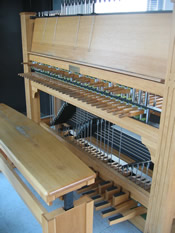Netherlands Carillon
In late 1951, Govert L. Verheul, press officer of the Dutch Ministry of Economic Affairs in The Hague, proposed that the Netherlands present a gift to the United States to commemorate their actions during and after World War II and as a symbol of the two countries' lasting friendship.
He came up with the idea of gifting a carillon when washing dishes one night and accidentally clinking wine glasses together.
On April 4, 1952, she visited the United States to present a small silver bell to President Harry S. Truman as a token of the carillon that was to come.
[3]Two years later, 49 bells arrived and were installed in West Potomac Park, where they were formally accepted by the United States.
The Netherlands did not initially have the money to provide a proper campanile for the carillon, so it was housed in a temporary structure.
The tower was erected just north of Arlington National Cemetery and south of the Marine Corps War Memorial and was completed by early 1960.
The carillon and new tower received a formal dedication ceremony on May 5, 1960, or the fifteenth anniversary of Dutch Liberation Day.
[1] A tulip garden was planted in a circular bed immediately to the east of the plaza in 1964, also a gift from the Netherlands.
A small successional woodland to the southwest forms the backdrop to the carillon as a result of the 1960s National Capital Parks Planting Plan.
He assumed the position of director-carillonist after his instrumental involvement in establishing the "Summer Series of Recitals on the Netherlands Carillon" in July 1963, sponsored by the US Department of the Interior.
The National Park Service announced a $300,000 (equivalent to $1,010,000 in 2023) renovation plan for the instrument in 1981, but budget issues delayed the project.
[5] Again, the tower was repainted the light gray blue color, neither time with the approval of the Commission of Fine Arts.
[4] Upon Mr. Law's death in 1985, the Netherlands Carillon fell silent until Edward M. Nassor took over the position of director-carillonist in 1987.
It was presented by the Dutch prime minister Wim Kok to the U.S. president Bill Clinton on February 28, 1995, and the renovated carillon was dedicated on May 5, 1995.
Due to severe rusting and fears of structural instability, the tower was closed to the public in the early 2010s.
In 2016, the National Park Service and Royal Netherlands Embassy launched a campaign to fundraise money for a $5,800,000 (equivalent to $7,400,000 in 2023[6]) restoration of the carillon.
[12] In the early 1950s, there were three major Dutch bell founders: Van Bergen, Royal Eijsbouts and Petit & Fritsen.
In order to avoid showing favoritism, all three founders were asked to cast the original forty-nine bells jointly and anonymously between 1952 and 1953.
You brought deliverance after the fearful dark of hunger, pain and shame: My bell tolls the gratitude of free Holland.
The lion striding of the Yssel unites what was once divided and binds us in holy understanding: unity is built on harmony.
A fiftieth bell, cast by Royal Eijsbouts, was added following Dutch- and American-sponsored renovations in 1995, and dedicated on May 5, the 50th anniversary of the liberation of the Netherlands.
[14] The 2019–21 renovation increased the size of the carillon to 53 bells, all cast by Royal Eijsbouts, and converted the instrument to concert pitch.
[15] These three additional bells are dedicated jointly to "75 Years of Freedom" and individually to people who had a major impact on the Netherlands and the United States during and after World War II: 1) General George C. Marshall for his role in the Marshall Plan, from which the Netherlands received over $1 billion for post-war reconstruction efforts; 2) the Martin Luther King Jr., for his role as the voice of the American civil rights movement; and 3) Eleanor Roosevelt, for her role as an advocate for social justice and human rights.
The original plans had called for the structure to be 270 feet (82 m) tall, but was then reduced after receiving concerns about its height in relationship to the Lincoln Memorial from the Commission of Fine Arts.
"[3] The interconnecting lines and rectangles of the structure's frame echo the work of Dutch abstract painter Piet Mondrian.
The tower's design also reflects the rejection of classical European architecture, which, in the years immediately following World War II, was associated with fascist regimes.
[17] The Netherlands Carillon is the first modernist steel memorial associated with the otherwise classical stone architecture found on the National Mall.
[18] The Netherlands Carillon stands on a 93 square feet (8.6 m2) quartzite plaza and is enclosed by a low lava stone wall.
The Netherlands Carillon is located just north of Arlington National Cemetery and south of the Marine Corps War Memorial.
A schedule of concerts and visiting carillonists is published on the National Park Service's website in the months before the season begins.




